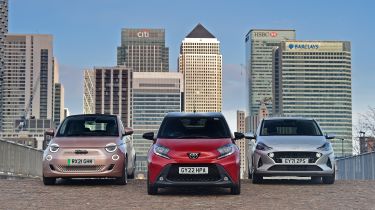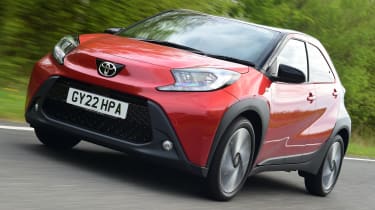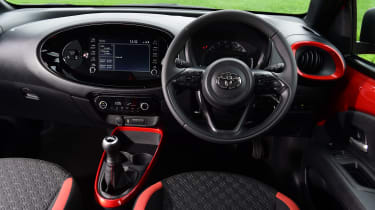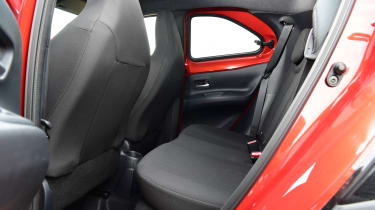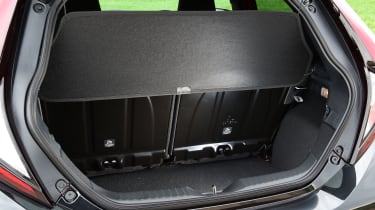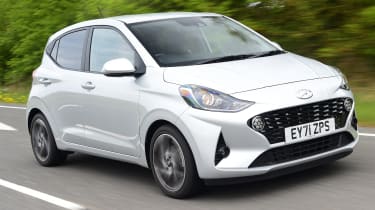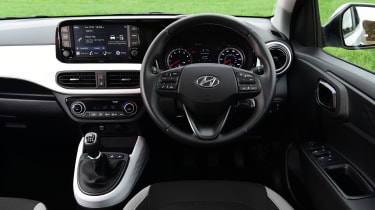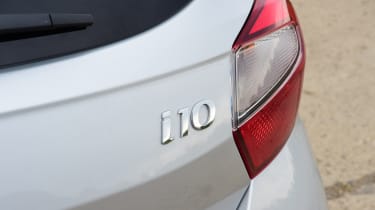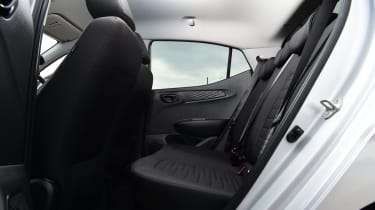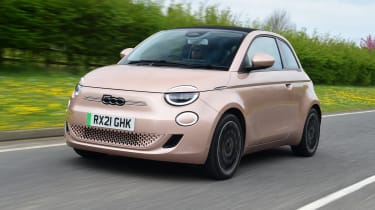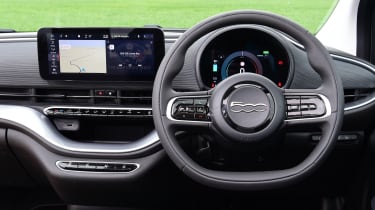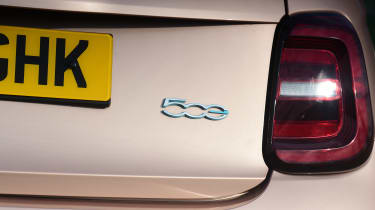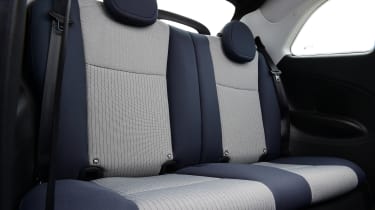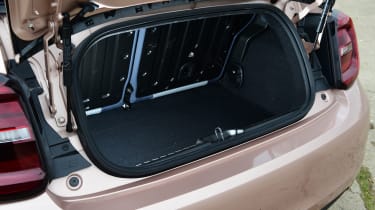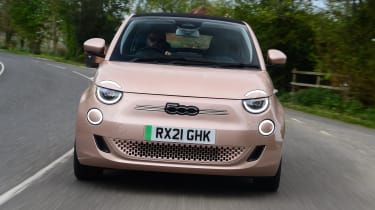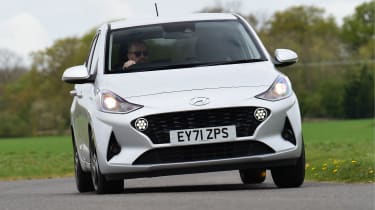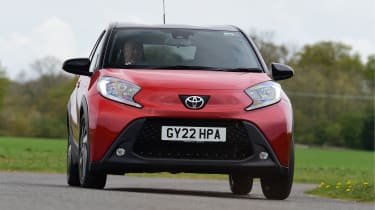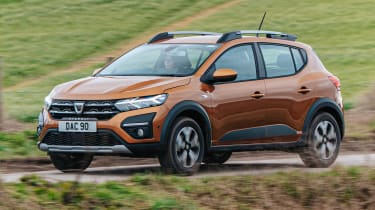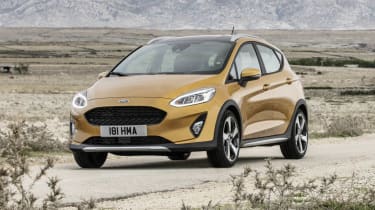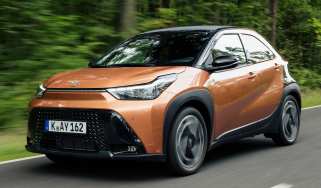Toyota Aygo X vs Hyundai i10 vs Fiat 500: 2022 group test review
The Toyota Aygo X goes to town with SUV style, but are its Hyundai and Fiat rivals better?
City driving is a tedious process. So much time is spent in gridlock – jams often made worse by drivers in vehicles much too large and obnoxious for their surroundings. City streets would be far more enjoyable places to be – and easier to park on – if everyone drove tiny cars like the three we’ve assembled here.
The latest arrival is the Toyota Aygo X, whose funky looks are the result of the Japanese maker taking its smallest model in a direction that plays to the SUV trends sweeping through the new-car market – but will its new style help it beat our current two favourite small cars?
Conventional competition comes from the Hyundai i10. On paper, the i10 is competitively priced, so does the Aygo X offer enough to justify its higher initial cost?
The Fiat 500 is an intriguing alternative. The electric model is pricier to buy than the Aygo X, but low everyday running costs might offset this. Is that enough for the little Italian to have the measure of our petrol city cars?
Toyota Aygo X
|
Model: |
Toyota Aygo X 1.0 VVT-i Edge |
|
Price: |
£16,505 |
|
Powertrain: |
1.0-litre 3cyl petrol, 71bhp |
|
0-62mph: |
14.9 seconds |
|
Test economy: |
51.9mpg/11.4mpl |
|
CO2: |
110g/km |
|
Annual road tax: |
£165 |
We’ll always welcome a newcomer into the city car class, and if the Aygo X has the substance to back up its eye-catching looks, then Toyota is on to a winner. We’ve got the mid-range Edge trim here, which costs £16,505 before options.
Used - available now

2023 Land Rover
Range Rover Velar
40,073 milesAutomaticDiesel2.0L
Cash £27,700
2023 Land Rover
Discovery Sport
40,379 milesAutomaticDiesel2.0L
Cash £26,200
2022 Land Rover
Range Rover Sport
20,876 milesAutomaticPetrol2.0L
Cash £39,000
2022 Volkswagen
ID.3
35,146 milesAutomaticElectric
Cash £14,400Design & engineering
Toyota split the cost of developing the first two generations of its Aygo city car with Peugeot and Citroen, whose 107/108 and C1 models were largely identical and built in the same factory. However, with the French firms withdrawing from the segment, this time Toyota has dipped into its own vast resources to make the venture worthwhile.
That’s because beneath that funky exterior, with its distinctive front end, two-tone paint, chunky SUV-inspired body cladding and oversized 18-inch alloy wheels, the Aygo X features a trimmed-down version of the platform used by the Yaris supermini. One upshot of this is that the new model has grown from the 3,455mm of the old car to 3,700mm. It’s still a small car, then, but not as dinky as it once was.
The outside has bags of character, which we reckon will be enough to draw in buyers all on its own. The cabin isn’t short on cheer, either; the dashboard is made up of a large, swooping oval that houses the infotainment screen and blends into the instrument panel, while it’s highlighted by lots of trim and upholstery that match whichever exterior colour you go for. On our test car, that included orange sections on the doors, seat bolsters and dashboard trim, plus highlights on the air vents.
Under the bonnet, Toyota has kept things simple. The single engine option is the same compact 1.0-litre three-cylinder petrol as the previous Aygo, which now produces 71bhp and 93Nm of torque. A five-speed manual gearbox is standard, while an automatic is offered for an extra £1,100.
Driving
While the Yaris underpinnings are a very promising place to start, the sophistication and refinement found in the supermini haven’t quite found their way into the Aygo X. The main issue is ride comfort; whether driving over pock-marked urban surfaces and speed bumps, or once up to speed out of town, there’s a harshness and a fidget to the Toyota’s ride that isn’t there in the Hyundai.
The powertrain doesn’t impress much, either. For starters, the three-cylinder engine has quite a pronounced vibration at idle, although it does smooth out somewhat under load. We wouldn’t expect a small city car to deliver storming straight-line speed, but the Aygo X feels all the more lethargic as a result of long gearing. It’ll hit 60mph in second gear, and first feels long, too; with so little power available at the lower end of the rev range, it takes plenty of revs and excessive clutch slip if you ever need to move off in a hurry. Despite the long lower gears, fifth is quite short, so the engine is noisier than the i10’s on the motorway, too.
There are positives, though. While we question the logic of the gearing, the shift quality of the manual transmission is slick. As you’d expect of a car so small, the Aygo X feels light and agile; it’s quite a lot of fun to drive in the crowded areas it’s designed for. It’s helped by the steering, which is light enough for the car to be easy to park, but still has sufficient weight to give confidence at higher speeds. It’s very precise too – in fact it’s the best set-up of this trio.
Practicality
There’s good and bad news with the Aygo X when it comes to everyday usability. That increased footprint when compared with its predecessor means it’s much more spacious inside – especially in the back. However, it’s still tighter than in the Hyundai.
In terms of head and kneeroom, it’s behind the i10, although there is a decent amount of foot space underneath the front seats. The rear bench is quite flat and not as comfortable as its rivals here. The rear doors are cut around those large wheelarches, and they’re very short, which means that it’s a bit of a squeeze to get inside. As with its predecessors, the Aygo X only has two seatbelts in the back.
At 231 litres, the boot capacity is only a little short of the 252 litres offered by the Hyundai, and quite far ahead of the 185-litre Fiat. The seats fold in a 50:50 split, while the parcel shelf is made from thin fabric and is very light, so it’s easy to move out of the way when it isn’t needed. Storage is okay, with a couple of cup-holders located in front of the gearlever and a cubby that’s deep and wide enough for a smartphone.
Ownership
Toyota takes a clear lead in this company when it comes to owner satisfaction. Of 19 brands in our Driver Power survey, it took an excellent fifth place overall, while its dealer network was ranked sixth best of 21.
By contrast, Hyundai took an underwhelming 16th as a brand and 15th for its dealers. And although Fiat’s dealers didn’t feature in the survey, it sat right near the bottom of the manufacturer listings, in 26th spot.
Running costs
Cheap fuel bills are a huge priority for any vehicle at the moment, but strong economy is particularly important in the city car segment. In this instance, the i10 pips the Aygo X, averaging 53.1mpg to the Toyota’s 51.9mpg. At current fuel prices, that’s the difference between spending £2,943 in the Toyota over the next 20,000 miles, to £2,877 in the Hyundai.
Neither can compete with the all-electric Fiat, though. Even in the worst-case scenario of home charging at the energy-capped rate of 28p per kilowatt hour, our 4.9-mile per kilowatt hour efficiency rating works out at £1,143 for 20,000 miles of driving – edging towards a third of what you’d spend putting petrol in the Aygo X or i10.
Testers’ notes: “The Aygo X’s back seats feel a little stuffy, not least because the small rear windows don’t lower. Like its predecessor, it has pop-out glass.”
Hyundai i10
|
Model: |
Hyundai i10 1.2 MPi Premium |
|
Price: |
£16,480 |
|
Powertrain: |
1.2-litre 4cyl petrol, 83bhp |
|
0-62mph: |
12.6 seconds |
|
Test economy: |
53.1mpg/11.7mpl |
|
CO2: |
125g/km |
|
Annual road tax: |
£165 |
Beside the Aygo X, the Hyundai i10 is very competitively priced. It’s possible to buy an i10 with a more powerful engine and in a higher trim level, but for an almost identical price to its rival. The model we have here is the 1.2-litre petrol in Premium trim, which comes to £16,480 before options – this undercuts the Toyota by £25.
Design & engineering
Hyundai has been able to succeed with the city car formula by splitting its development costs two ways, because the i10 shares its platform with its relative from Kia, the Picanto.
The i10 (and its predecessor, the Atoz) has always had quite boxy, upright proportions in order to maximise practicality in a small overall package. Now in its third generation, the i10 has taken on its sleekest shape yet – although next to its style-led rivals here, it definitely still prioritises function over form.
The same applies inside, where the cabin design looks a little plain when compared with its competitors. It all feels solid enough, though, and the ergonomics are great; the driving position is comfortable, the view out is clear and the gearlever is raised quite high, so it’s close to the steering wheel. There’s more space in the footwell to rest your left foot than in the 500, too, which is completely lacking any sort of foot rest.
While the Toyota is limited to just one engine choice, the i10 is offered with three. The entry point is a 1.0-litre three-cylinder unit with stats that closely match the Aygo X’s – it makes 66bhp and 96Nm. The engine tested here increases to 1.2 litres and adds an extra cylinder, and has 83bhp and 117Nm to show for it. The range tops out with a turbocharged T-GDi version of the three-cylinder, which is exclusive to the sporty N Line trim and serves up 99bhp and 172Nm. That results in a 0-62mph time of 10.5 seconds – almost enough to give the sporty Volkswagen up! GTI a run for its money.
Driving
When it comes to the driving experience, the i10 very much lives up to any assumptions you’d make from its sensible appearance. It’s a more mature, refined take on the city car than the Aygo X; the ride is the smoothest of this trio, while a mix of a longer fifth gear and well suppressed wind noise means that it’s a more relaxed cruiser than the Toyota as well.
The trade-off for this more grown-up behaviour is that it’s not as much fun to drive. Next to the Toyota, the Hyundai feels a little lazy to turn into corners; there’s slightly more body roll, and the tyres don’t deliver quite as much grip. On the plus side, the steering is light, which – as with the others here – means that parking the i10 is an absolute doddle.
The four-cylinder unit in the Hyundai is much sweeter than the Toyota’s triple. It’s smoother at lower speeds, yet produces more power. Although the difference is clear from the gap between the pair’s 0-62mph times – 14.9 seconds for the Aygo X, 12.6 seconds for the i10 – what this means in the real world is that the Hyundai is much happier to keep up with traffic on the open road, and is less of a hardship to drive when you want to carry a couple of passengers. The manual gearbox isn’t as sweet as the Aygo X���s, though, with a slightly sloppy feel through the gate.
Practicality
The Hyundai feels like the least cheerful car inside and out, but it’s easily the most practical. Considering the i10’s size, it’s impressive how well packaged it is when compared to rivals with a similar footprint.
If you regularly need to carry people in the back, then there’s no question that this is the car to have, even down to the simple fact that the back doors are sensibly sized, so adults won’t struggle to climb in. Once there, they’ll find the Hyundai is comfortably the most spacious option in terms of both knee and headroom.
It’s also a rarity in this segment – and unique in this group – because it’s the only car with space for three in the back. A middle passenger will definitely make things a tight squeeze, but at least the flexibility is there. In terms of storage, the door bins are deep front and rear, and the glovebox is roomy, too.
Ownership
Every Hyundai comes as standard with a five-year, unlimited-mileage warranty. Against most competition, that’s very impressive cover, but Toyota’s protection is even longer, offering drivers up to 10 years or 100,000 miles of coverage. There is one caveat to that, however: in order to get that full period, you must ensure that the car is serviced on schedule at an official Toyota dealer every year.
Beside the other two, the Fiat’s three-year/unlimited-mileage package seems a little short. However, EV newcomers will be reassured by the fact that any defects in the battery pack are covered for eight years or 100,000 miles. All three cars are offered with one year’s complimentary breakdown cover.
Running costs
This trio manage to cling on to their original value quite gamely when compared with the new-car market as a whole. The Aygo X fares best, and is predicted to maintain 55.4 per cent of its original asking price after three years. The Hyundai isn’t far behind, holding on to a predicted 53 per cent. The more expensive Fiat splits the two, meanwhile; it’s set to be worth 53.5 per cent of its original asking price after the same period.
In cash terms, that means that the Toyota will lose the least money over three years – £7,355 in total, compared with £7,741 for the Hyundai and £13,386 for the pricier Fiat.
Testers’ notes: “The i10 is also available with an automated manual gearbox. Unless you absolutely must have an auto, then avoid it – it’s pretty poor.”
Fiat 500
|
Model: |
Fiat 500 42kWh Icon |
|
Price: |
£28,780 |
|
Powertrain: |
E-motor, 42kWh battery, 116bhp |
|
0-62mph: |
9.0 seconds |
|
Test economy: |
4.9 miles/kWh |
|
CO2: |
0g/km |
|
Annual road tax: |
£0 |
The model shown in our images is the 500 Cabriolet, which features a retractable canvas hood. But we’re testing the 500 in more practical – and cheaper – hatchback guise, which in Icon trim still weighs in at a hefty £28,780. Does the electric powertrain make the extra outlay worthwhile?
Design & engineering
Developing a city car from the ground up is a difficult process, which is why Toyota used an evolution of a tried-and-tested platform for the Aygo X. In creating an all-electric model, Fiat didn’t have that choice – the latest 500 is a clean-sheet design. However, the iconic jellymould profile stays, and is highlighted by plenty of stylish details; the LED headlights are split by a clamshell bonnet, while the smooth flanks are punctuated by a single chrome-effect strip that neatly integrates the flush door pulls. Of the three, it definitely gives off the best impression of a premium product.
That continues inside, too. In terms of materials, there’s no significant jump beyond the other two – the dash plastics are still hard – but the understated dashboard design, which features body-coloured sections in some versions, looks closer to a premium hatch like a Mini than something that’s built down to a price. The driving position is quite high and it’s a shame that there’s no rest for your left foot, but the simplicity elsewhere shows that thought has gone into the design. The climate control switches are located on a single bank of piano-style keys, the digital dash is easy to read and the steering wheel buttons are well laid out.
There are two powertrains to choose from in the 500. The entry-level model gets a 92bhp electric motor paired with a 23.9kWh battery that’s good for an official range of 115 miles. That will be perfectly fine for use as a second car, but will be limited for anyone wanting to cover longer distances. The next model – and the one we’re testing here – gets a bigger battery and more power, at 116bhp. The 42kWh pack increases the overall range to 199 miles.
Driving
The 500’s simplicity continues when it comes to moving off. The gear selector is laid out as four large buttons side-by-side; prod ‘D’ and the 500 moves off smoothly and silently. Compared with its rivals here, the benefits of an electric drivetrain are obvious within a couple of yards of pulling away. There’s no vibration whatsoever, and when that’s combined with little more than a distant whirr from the motor, it makes the 500 feel incredibly sophisticated in this company. It’s so easy to control the accelerator (ideal when trying to drive smoothly in traffic or park in a tight space) and when you push the pedal harder, there’s far more acceleration available, too. A 0-62mph time of nine seconds flat means the 500 is comfortably the quickest car here, and keen responses make it feel even more urgent.
Although harder stops are taken care of by mechanical brakes, the electric motor looks after gentler deceleration while putting charge back into the battery to extend the car’s range. The energy regeneration can be made stronger by selecting the Sherpa driving mode, which also limits the 500’s speed and cuts back the power of the climate control to extract as many miles of range as possible. For EV users who like one-pedal driving, this is the only mode in which it engages, which is disappointing.
Refinement is fine for a small car. As with the i10, there’s a little wind noise around the front pillars, but otherwise it’s not bad. The Fiat’s ride is a little more fidgety than the Hyundai’s, but smoother than the Toyota’s. That battery pack is heavy, so the 500 weighs roughly 400kg more than its sub-1,000kg rivals. As a result, it doesn’t feel quite as nippy through turns, but the position of the battery under the floor means that the centre of gravity is low, so it feels stable and secure.
Practicality
If you’re looking for a spacious family car, then the 500 isn’t for you. The back seats are the most cramped of the three cars here, both for head and legroom, while the Fiat’s 185-litre boot will be good for little more than a modest supermarket shop.
If you only intend to use those back seats sparingly, though, the 500 should be fine. The open space between the front footwells and that bubble-shaped roof mean that, for those up front, it feels spacious and airy. The windows are large, which, combined with the high driving position, results in the best all-round visibility here.
While getting child seats into such tight rear quarters will likely prove to be a stressful business, the good news is that the front passenger seat is also equipped with Isofix mounts.
Ownership
While the petrol city cars can be refuelled in a matter of minutes, the 500 has the benefit of being able to be charged from home – potentially overnight, when electricity rates can be cheaper because demand on the grid is lower. Plugged into an 11kW charger, the process takes four hours and 15 minutes. If you’re on the move, the Fiat can accept a recharge of up to 85kW at a public rapid charger. That means a zero to 80 per cent top-up takes around 35 minutes.
Running costs
The Fiat’s range will vary based on temperature throughout the year. In the warm conditions of our test, it achieved an excellent 4.9 miles per kWh – enough for 209 miles between charges. However, a long-term test over winter averaged 4mi/kWh – enough for 168 miles.
If you’re a company car user, then choosing the 500 is a no-brainer. It sits in the lowest two per cent Benefit-in-Kind band, so a standard-rate income taxpayer will face deductions of just £115 per year, compared with £879 for the Toyota and £974 for the Hyundai.
Testers’ notes: “It’s easiest to find a comfortable driving position in the 500 because it’s the only car here to have reach adjustment for the steering wheel.”
Verdict
First place: Fiat 500
Yes, the Fiat is the most expensive car here, but it really feels like it. In terms of quality, tech, refinement and performance, it’s well clear of its rivals, and thanks to the potential savings made possible by its efficient electric powertrain, the total cost of ownership narrows the gap to its rivals. If you can live with the tiny back seats and modest boot capacity, then the Fiat 500 is still the best city car around.
Second place: Hyundai i10
If a combustion powertrain suits your lifestyle better, then the i10 is deeply appealing. The flexibility in the range means you can either pay similar cash to the Aygo X and have a car that’s more powerful, more comfortable and just as frugal, or save hundreds and get a car that matches the Toyota on performance. If your car-buying preferences focus on the sensible stuff, then the i10 is a brilliant choice.
Third place: Toyota Aygo X
There’s plenty to like about the Aygo X. We applaud Toyota for taking a different approach to maintain its challenge in a shrinking class, and the new model adds a sense of fun that is certain to be a hit with city car buyers. Competitive finance deals mean that monthly payments are on a par with the i10’s, but the Aygo X can’t match the Hyundai when it comes to refinement or practicality.
Other options for similar money
New: Dacia Sandero Stepway Prestige
- Price: £15,895
- Engine: 0.9-litre 3cyl turbo, 89bhp
What really shines a light on the Aygo X’s price is the value for money offered by the Sandero Stepway. It’s a more refined, spacious and powerful small car with SUV-inspired styling that, even in its top trim level, is significantly cheaper to buy. It’s an absolute bargain.
Used: Ford Fiesta Active X (2020)
- Price: £17,000
- Engine: 1.0-litre 3cyl, 123bhp
Ford also gave its Fiesta the pseudo-SUV treatment, and the Active has clever hydraulic bump stops to improve ride comfort. That and the extra body cladding aside, it’s still the same Fiesta: cheap to run, spacious enough and brilliant fun to drive.
Figures
|
Fiat 500 Electric Icon |
Hyundai i10 1.2 MPi Premium |
Toyota Aygo X 1.0 VVT-i Edge | |
|
On the road price/total as tested |
£28,780/£28,780 |
£16,480/£17,030 |
£16,505/£16,825 |
|
Residual value (after 3yrs/36,000) |
£15,394/53.5% |
£8,739/53.0% |
£9,150/55.4% |
|
Depreciation |
£13,386 |
£7,741 |
£7,355 |
|
Annual tax liability std/higher rate |
£115/£230 |
£974/£1,948 |
£879/£1,758 |
|
Annual fuel cost (12k/20k miles) |
£571/£1,143 |
£1,726/£2,877 |
£1,766/£2,943 |
|
Insurance group/quote/VED |
17/£361/£0 |
8/£282/£165 |
7/£440/£165 |
|
Cost of 1st/2nd/3rd service |
£299 (3 years) |
£147/£249/£155 |
£180/£280/£180 |
|
Length/wheelbase |
3,632/2,322mm |
3,670/2,425mm |
3,700/2,430mm |
|
Height/width |
1,527/1,683mm |
1,480/1,680mm |
1,525/1,740mm |
|
Powertrain |
1x electric motor/lithium-ion battery |
4cyl in-line/1,197cc |
3cyl in-line/998cc |
|
Peak power/revs |
116bhp/N/A |
83/6,000 bhp/rpm |
71/6,000 bhp/rpm |
|
Peak torque/revs |
220Nm/N/A |
118/4,200 Nm/rpm |
93/4,300 Nm/rpm |
|
Transmission |
Single-speed/fwd |
5-speed man/fwd |
5-speed man/fwd |
|
Battery capacity |
42kWh |
N/A |
N/A |
|
Fuel tank capacity/spare wheel |
N/A/repair kit |
36 litres/repair kit |
35 litres/repair kit |
|
Boot capacity (seats up/down) |
185/550 litres |
252/1,050 litres |
231 litres/N/A |
|
Kerbweight/payload |
1,365/400kg |
932/498kg |
950/410kg |
|
Turning circle |
9.7 metres |
9.7 metres |
9.4 metres |
|
Basic warranty (miles)/recovery |
3yrs (unlimited)/1yr |
5yrs (unlimited)/1yr |
10yrs/1yr |
|
Driver Power manufacturer/dealer pos. |
26th/N/A |
16th/15th |
5th/6th |
|
NCAP: Adult/child/ped./assist/stars |
N/A |
69/75/52/59/3 (2020) |
N/A |
|
0-62mph/top speed |
9.0 secs/93mph* |
12.6 secs/106mph |
14.9 secs/98mph |
|
Auto Express economy/range |
4.9mi/kWh/206 miles |
53.1mpg/421 miles |
51.9mpg/400 miles |
|
WLTP combined/WLTP range |
N/A/199 miles |
51.4mpg/N/A |
56.4mpg/N/A |
|
Actual/claimed CO2/tax bracket |
0/0g/km/2% |
123/125g/km/30% |
126/110g/km/27% |
|
Charging capability |
2.3/11/85kW |
N/A |
N/A |
|
Charging time |
15h15m/4h15m/35m** |
N/A |
N/A |
|
Airbags/Isofix/parking sensors/cam |
Six/yes/rear/yes |
Yes/yes/no/yes |
Yes/yes/£295/yes |
|
Auto box/lane-keep/blind spot/AEB |
Yes/yes/£850***/yes |
£500/yes/no/yes |
£1,100/yes/no/yes |
|
Clim./cruise ctrl/leather/heated seats |
Yes/yes/no/£450^ |
Yes/yes/no/yes |
Yes/adaptive/no/no |
|
Met. paint/LEDs/keyless/pwr tailgate |
£600/£850`/yes/no |
£550/no/no/no |
£320/yes/no/no |
|
Sat-nav/digital dashboard |
Yes/yes |
£1,000°/no |
No/no |
|
DAB radio/connected services |
Yes/yes |
Yes/£1,000° |
Yes/yes |
|
Wireless charge/CarPlay/Android Auto |
£130/wireless/wireless |
£1,000°/yes/yes |
Yes/yes/yes |
